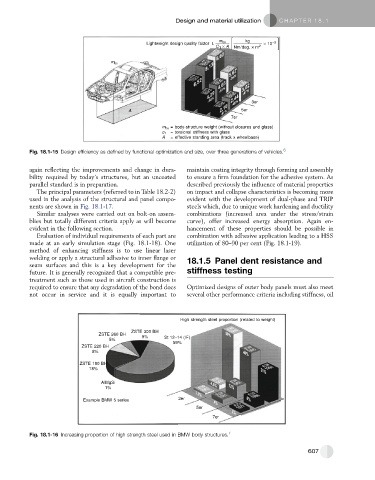Page 596 - Automotive Engineering Powertrain Chassis System and Vehicle Body
P. 596
Design and material utilization C HAPTER 18.1
⎡ kg ⎤
×
Lightweight design quality factor L m bs ⎢ 10 –3 ⎥
C T × A ⎢ ⎣ Nm/deg. m 2 ⎦ ⎥
×
m bs
3er
A 5er
7er
m bs = body-structure weight (without closures and glass)
c T = torsional stiffness with glass
A = effective standing area (track x wheelbase)
Fig. 18.1-15 Design efficiency as defined by functional optimization and size, over three generations of vehicles. 6
again reflecting the improvements and change in dura- maintain coating integrity through forming and assembly
bility required by today’s structures, but an uncoated to ensure a firm foundation for the adhesive system. As
parallel standard is in preparation. described previously the influence of material properties
The principal parameters (referred to in Table 18.2-2) on impact and collapse characteristics is becoming more
used in the analysis of the structural and panel compo- evident with the development of dual-phase and TRIP
nents are shown in Fig. 18.1-17. steels which, due to unique work hardening and ductility
Similar analyses were carried out on bolt-on assem- combinations (increased area under the stress/strain
blies but totally different criteria apply as will become curve), offer increased energy absorption. Again en-
evident in the following section. hancement of these properties should be possible in
Evaluation of individual requirements of each part are combination with adhesive application leading to a HSS
made at an early simulation stage (Fig. 18.1-18). One utilization of 80–90 per cent (Fig. 18.1-19).
method of enhancing stiffness is to use linear laser
welding or apply a structural adhesive to inner flange or 18.1.5 Panel dent resistance and
seam surfaces and this is a key development for the
future. It is generally recognized that a compatible pre- stiffness testing
treatment such as those used in aircraft construction is
required to ensure that any degradation of the bond does Optimized designs of outer body panels must also meet
not occur in service and it is equally important to several other performance criteria including stiffness, oil
High strength steel proportion (related to weight)
ZSTE 300 BH
ZSTE 260 BH 9%
5% St 12–14 (IF)
59%
ZSTE 220 BH
8%
ZSTE 180 BH
18%
AIMgSi
1%
3er
Example BMW 5 series
5er
7er
Fig. 18.1-16 Increasing proportion of high strength steel used in BMW body structures. 7
607

